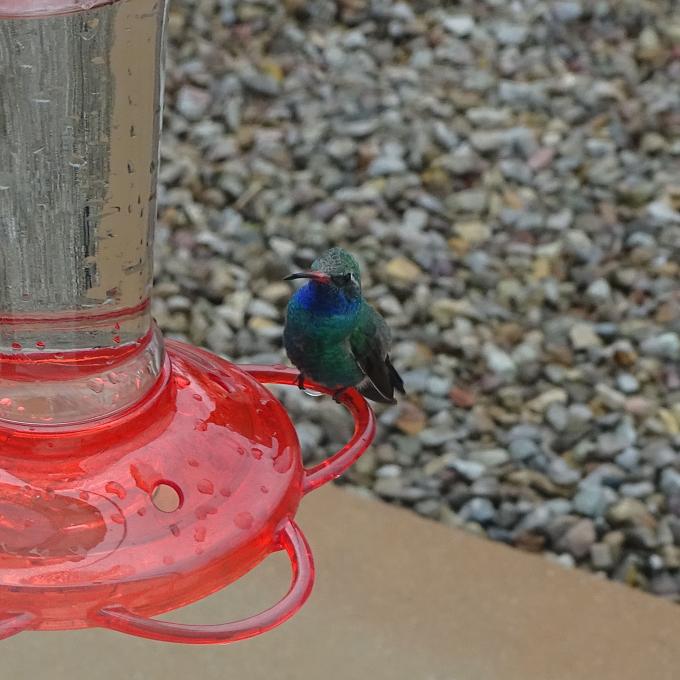The Cornell Lab Bird Academy › Discussion Groups › The Wonderful World of Hummingbirds › What Makes a Hummingbird a Hummingbird
-
I only have seen the ruby-throated to my knowledge. I do put out nectar for them in spring, summer and early fall. Here in Georgia our weather is warm for quite a long time. They are such a joy to watch. This past summer I enjoyed two hummers dancing in the rain in front of my porch. I didn't get a photo because I knew if I moved they would fly on. It was such a joy.
-
I have only seen two. One was at my parents' house (last year in Tampa, Florida) and the other was in California near Muir Beach (in March of this year). Each time was only a few seconds, but both times were magical! The one in Tampa was probably a Ruby-Throated Hummingbird; I'm not sure about the one in California. For anyone interesting in reading about hummingbirds, I recommend The Glitter in the Green: In Search of Hummingbirds by Jon Dunn. I read it earlier this year. It was very interesting and included a lot of amazing photos of a variety of hummingbirds!
-
We live in Las Vegas and have hummingbird feeders. We always have Anna's Hummingbirds, during the summer we have Black Chinned Hummingbirds, and in the winter we have Costa's Hummingbirds.
-
I live in New York and usually we only have Ruby-throated Hummingbirds, but this year, a Black-chinned Hummingbird showed up on Randall's Island (1st record for the state) and last year, a Calliope Hummingbird showed up on Long Island, NY. I always wonder how vagrants get to where they end up and if it will become part of a larger trend of birds from warmer climes becoming more common.
-
I've been feeding hummingbirds for a few years now. Here in the heart of northern California, I mostly see a lot of Anna's year round and Rufous hummingbirds during migration times. I have anywhere from 9 to 12 feeders up, depending on the season and weather conditions (more during rainy days). One particular feeder (with 7 feeding ports and 4-cup capacity) gets emptied twice a day (once by mid-day and then by the end of the day). I guess they like that model or location, or something. So, lots of hummingbirds here!
-
I see Ruby throated hummingbirds regularly here in Quebec. Last year I drove across Canada to Vancouver and saw Anna, Rufous and Caliope hummingbird. Beautiful!
-
I have no images to send.
-
I am fortunate to live in an area in Southern California with a number of hummingbirds around our neighborhood. My wife and I often see Anna's hummingbirds and Allen's hummingbirds with some frequency. I had no idea there were so many different families or species of hummingbirds throughout our hemisphere, though. We feel very lucky every time we get to see one of these beautiful birds.
-
We have ruby throated hummingbirds visit our honeysuckle every summer. I can usually count on seeing 1-2 every day during dinnertime, and I've seen a few interesting activities. One time the hummingbird was chasing bees away from the honeysuckle, and another time two birds spiraled up really high into the sky - I'm guessing another territorial battle? We were in Peru last year, and I wish I had seen some of the species native to that area - we'll have to go back to South America!
-
In July, my husband and I bought a log cabin at the base of a mountain. The previous owners had 10 hummingbird feeder territories in full swing, and we were instantly initiated into the amazing world of hummingbirds. In our area, we have Ruby Throated hummingbirds, and to sit outside with dozens of them buzzing, chirping, and visiting is magical. They really do just fly right up to your face to check you out! They especially love to perch on our bonsai trees nearby. Now in October most of them have flown south and we seem to have a few stragglers and migrating hummers making a pit stop.


-
so, it isn't necessary to have feeders with any red color to them? doesn't help to attract them?
-
@Gloria The ports on the feeders are red, and the feeder on the left has quite a bit of red in it (I think it is the lighting in my photo that is misleading). But these hummingbirds know to come back to our feeders every year, so I do not need to use much red to attract them. They have an amazing memory for feeder locations.
-
-
 For the first time in my life a hummingbird visited my yard this August and September. I was filled with joy. It was a female ruby throat. Is that what they’re called? I live on Long Island NY. She shooed away at least 3 others and stayed almost all day long the last 3 days before migration. When she left I was so sad. She actually came to check me out. So sweet. So smart and curious. I’m sad she left.
Carmela
For the first time in my life a hummingbird visited my yard this August and September. I was filled with joy. It was a female ruby throat. Is that what they’re called? I live on Long Island NY. She shooed away at least 3 others and stayed almost all day long the last 3 days before migration. When she left I was so sad. She actually came to check me out. So sweet. So smart and curious. I’m sad she left.
Carmela
-
I was lucky enough to take a guided trip to SE Arizona during monsoon season this past August. We saw 14 species of hummingbirds, my favorite was the Berryline with its brilliant green head. It was really fun going to different feeders either at parks or preserves or where people let you go in their backyard to wait for birds. Waiting one day a Coopers Hawk swept in but left without catching anything.
-
I am fortunate to live in southern California and have Allen's, Anna's, Costa's regularly come to my feeders. I have even had a Black-chinned on occasion. I have several feeders, spread out, because one of the Allen's Hummingbirds is quite a defender of the food source.
-
We had a female Ana's Hummingbird make a nest in our courtyard for years and it was always fun seeing her year after year. Sometimes she would have two nests in a season! She'd always divebomb John, my second dad since he's taller than Mom and I, whenever he'd be heading to the front door, though.
-
Ruby throated hummingbirds are frequent visitors to my blueberry bushes which are right outside my dining room window. I love to watch them while I eat.
-

 I live in Northeastern U.S. where we only have Ruby-throated hummingbirds. I never get tired of watching them! It's sad when they head south in late summer, but always exciting when they return in the spring. They always come around looking for the feeder before I put it out. It's fascinating to watch the males courting the females, but I've never found a nest.
I live in Northeastern U.S. where we only have Ruby-throated hummingbirds. I never get tired of watching them! It's sad when they head south in late summer, but always exciting when they return in the spring. They always come around looking for the feeder before I put it out. It's fascinating to watch the males courting the females, but I've never found a nest. -
Is that a male ?
-
-
I have been into hummingbirds for a few years and have gone to festivals in Rockport, Texas and Sedona ,Arizona. Now I am living in Mexico City and I see many berry linea or berry line hummingbirds here more than another species. I cant believe how in a city this big theses bird found a way to live and survive.
-
Oh, yes. Rufous HU make it up here (58 N). And we often have at least one pair all summer in our blueberry and moss understory to hemlock and spruce Most memorable is my week in Costa Rica with Operation Rubythroat. Active participation in running mist nets and banding I remember the vigorous Cinnamon Stars
-
 This summer I had the privilege of watching a Ruby-throated nesting in the woods behind our deck, from the building of the nest until it’s abandonment after use. We live in northeastern Pennsylvania. This is a digi-scoped picture of the two nestlings the day before they fledged.
This summer I had the privilege of watching a Ruby-throated nesting in the woods behind our deck, from the building of the nest until it’s abandonment after use. We live in northeastern Pennsylvania. This is a digi-scoped picture of the two nestlings the day before they fledged. -
Yes! We have a hummingbird feeder that we haven't seen birds at for a couple of years, but this year there have been two juveniles visiting daily for a couple of weeks :)
-
Yes! I saw my first hummingbirds this summer at a public butterfly garden maintained by the Bergen County Audubon Society, and, inspired by them, I planted my own hummingbird garden in my yard. So far I have seen a hummingbird on three separate visits to my cardinal flowers after only a few weeks! I believe my hummingbird is a female Ruby-throated.

-
I have seen many hummingbirds in the places I've lived and visited, mostly near gardens or feeders. But the most enchanting sightings have been when I am backpacking, sitting at the top of a mountain pass, when suddenly I get investigated by a hummingbird! I have been in the Sierras, on top of Pinchot and Mather passes, and had hummingbirds close up, checking me out eye to eye. I recently was in the Bob Marshall Wilderness near the Chinese Wall, and a hummingbird visited our group of three while we were having dinner, flying right into the circle and looking at us each in turn. These were all such a surprise! Such odd behavior checking out the humans.
-
Here in the Sonoran Desert (Southern Arizona), I've seen mostly Anna's, Allen's, Costas and Broadbills (photo) at my feeders. Recently, several aggressive Rufous have laid claim to my primary feeder. So far, they've been too fast to photograph. They attempt to intimidate the others, but many are brave enough to fight back or simply sit in the nearby trees until the bullies leave. Enjoying this course!

-
A few years ago my wife and I took a bird tour to Cuba. We were lucky enough to see several hummers including the Bee Hummingbird, which was our grail bird for the trip.
-
Hi Dough. How can I find out about hummingbird trips like u did? Carmela
-
-
I live in the SF Bay area. We commonly have Ann'a at our feeder's and occasionally see Allen's and Rufous in the area. Recently saw Rufous in Alaska. My first experience with a hummingbird was at a friend's house in La Jolla, near San Diego., let alone differentiate We were able to corral it and get it outside unharmed. This was long ago and none of us even knew about different species. A number of years ago my wife and I were at a desert zoo near Palm Springs. My wife was wearing a bright red shirt with a flower print. Not sure of the species but i think it was a Costa's. It approached my wife's shirt as if to feed at the flowers but it realized its mistake and buzzed off.
Read More:
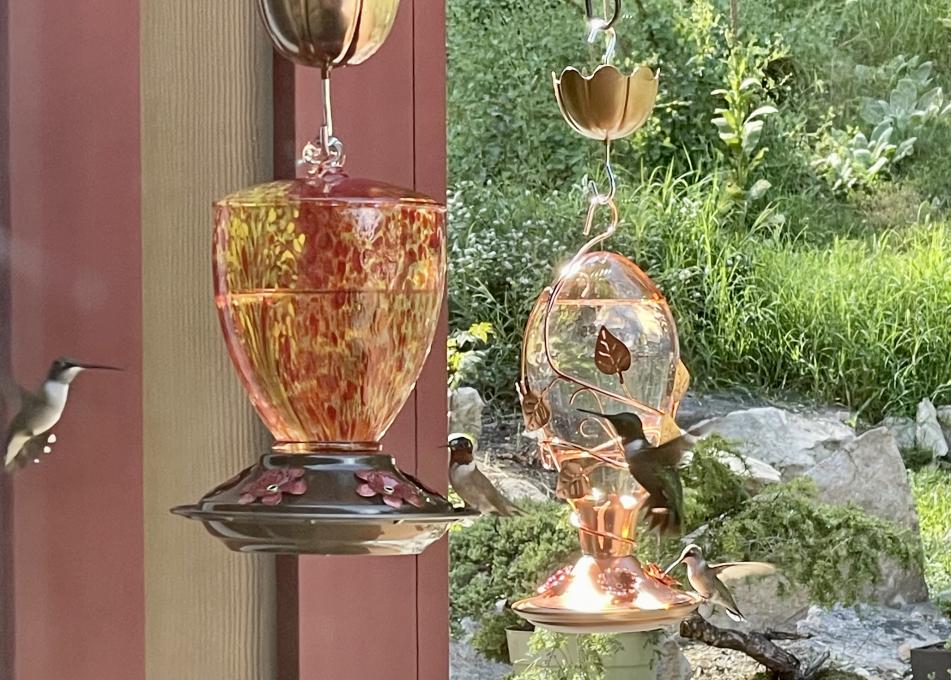
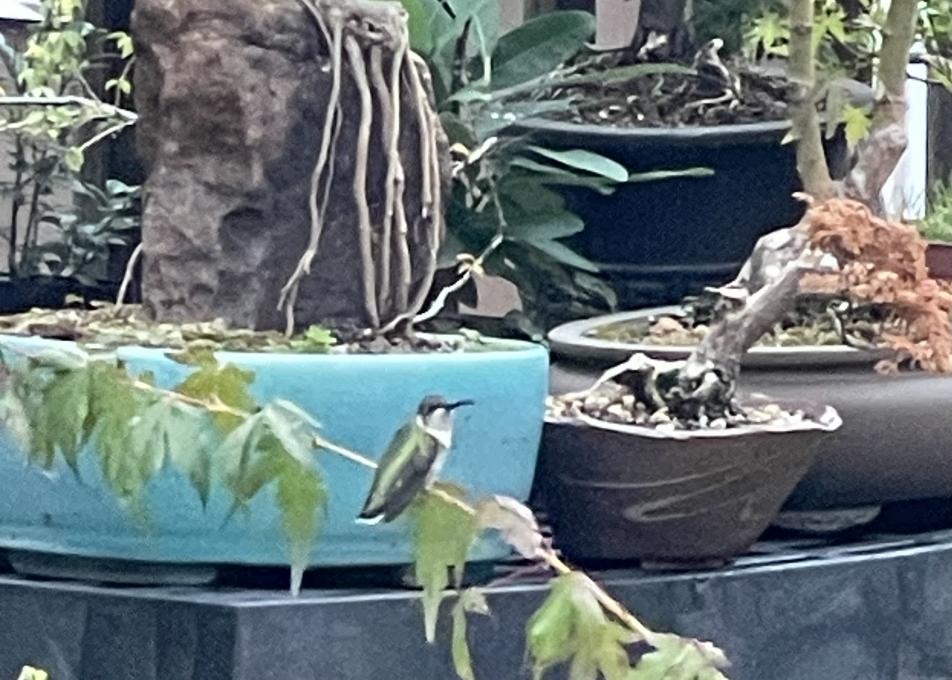
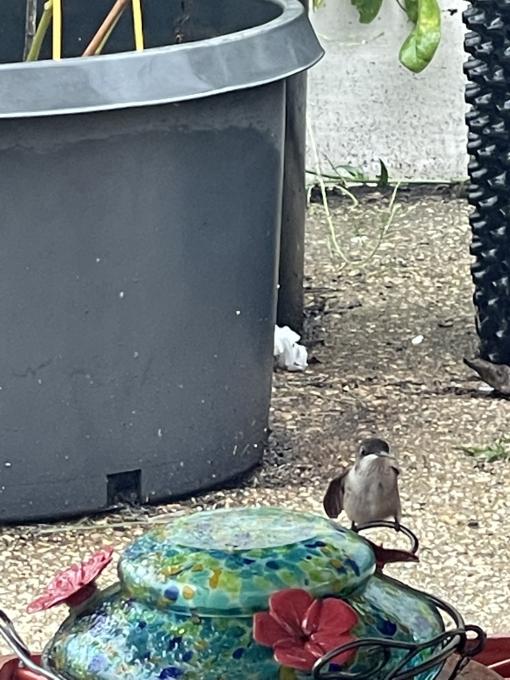 For the first time in my life a hummingbird visited my yard this August and September. I was filled with joy. It was a female ruby throat. Is that what they’re called? I live on Long Island NY. She shooed away at least 3 others and stayed almost all day long the last 3 days before migration. When she left I was so sad. She actually came to check me out. So sweet. So smart and curious. I’m sad she left.
Carmela
For the first time in my life a hummingbird visited my yard this August and September. I was filled with joy. It was a female ruby throat. Is that what they’re called? I live on Long Island NY. She shooed away at least 3 others and stayed almost all day long the last 3 days before migration. When she left I was so sad. She actually came to check me out. So sweet. So smart and curious. I’m sad she left.
Carmela
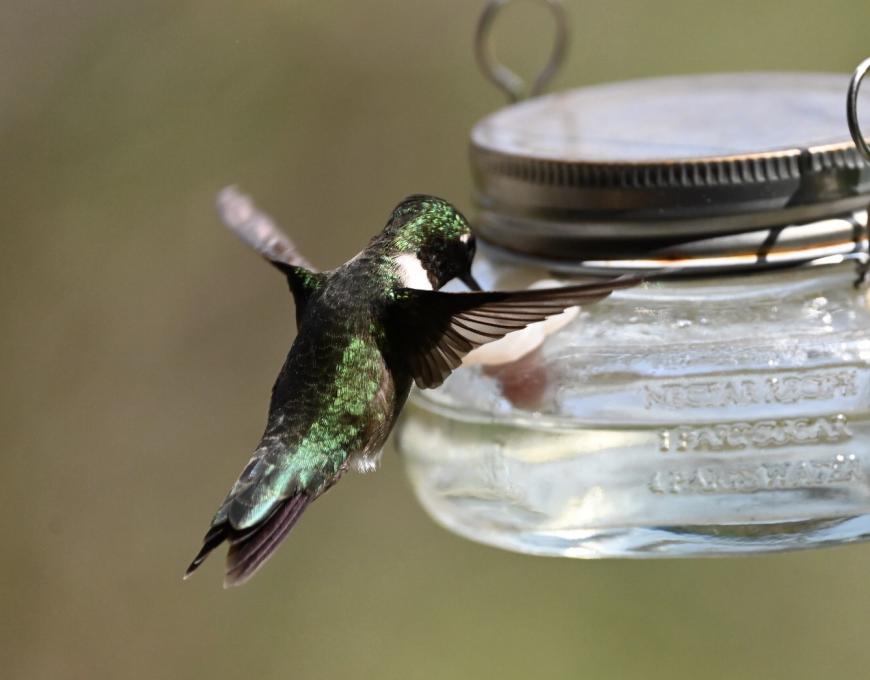
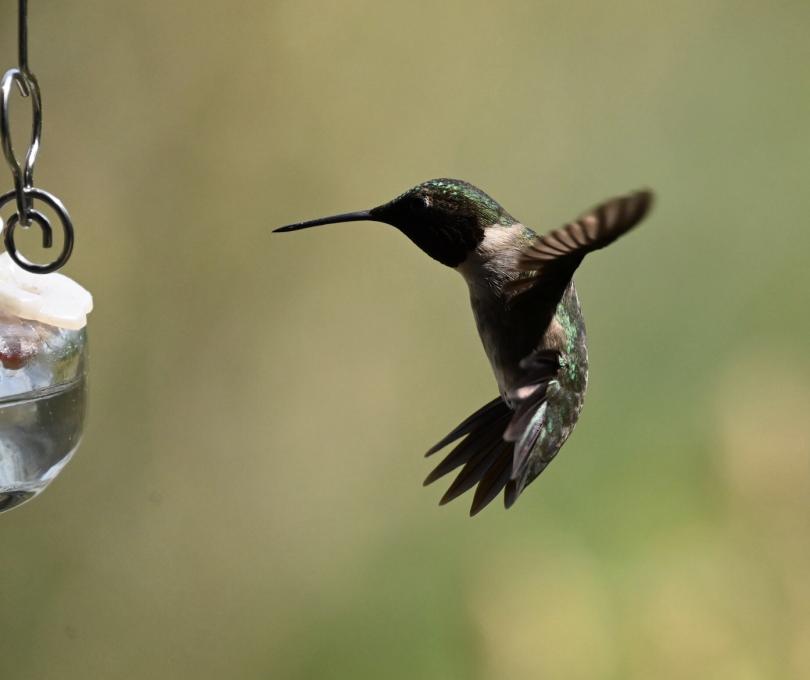 I live in Northeastern U.S. where we only have Ruby-throated hummingbirds. I never get tired of watching them! It's sad when they head south in late summer, but always exciting when they return in the spring. They always come around looking for the feeder before I put it out. It's fascinating to watch the males courting the females, but I've never found a nest.
I live in Northeastern U.S. where we only have Ruby-throated hummingbirds. I never get tired of watching them! It's sad when they head south in late summer, but always exciting when they return in the spring. They always come around looking for the feeder before I put it out. It's fascinating to watch the males courting the females, but I've never found a nest. 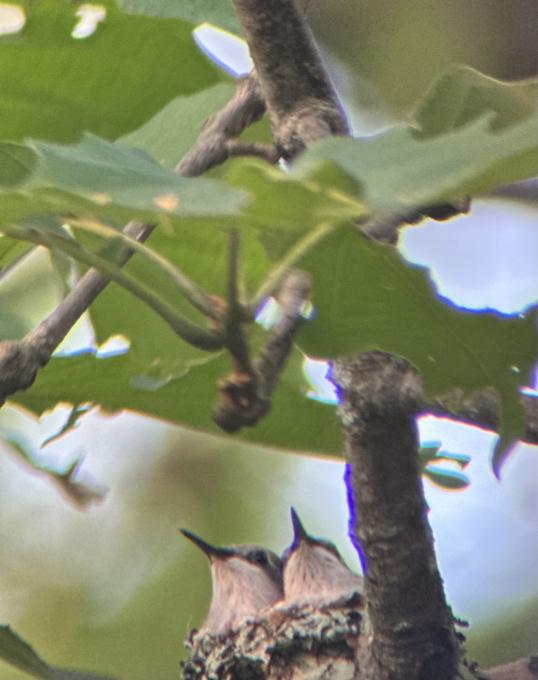 This summer I had the privilege of watching a Ruby-throated nesting in the woods behind our deck, from the building of the nest until it’s abandonment after use. We live in northeastern Pennsylvania. This is a digi-scoped picture of the two nestlings the day before they fledged.
This summer I had the privilege of watching a Ruby-throated nesting in the woods behind our deck, from the building of the nest until it’s abandonment after use. We live in northeastern Pennsylvania. This is a digi-scoped picture of the two nestlings the day before they fledged. 
